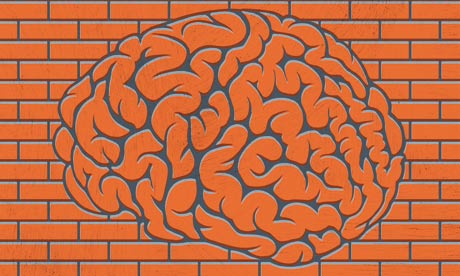
In the corporate team-building exercise known as 100 Uses For A Brick, employees are presented with an ordinary brick, then asked to come up with 100 ways to restrain their rage at being forced to participate in moronic team-building exercises when they could be getting on with work. Or something like that; I may be misremembering. Anyway, the point is to encourage fresh thinking by looking beyond a brick's conventional uses, thereby overcoming one of the biggest barriers to creativity: "functional fixedness", the way our brains become locked into defining an object by the purpose to which it's usually put. The most famous experimental demonstration of this involved handing people a candle and a box of drawing pins, with instructions to fix the candle to the wall. Most tried pinning the candle, or melting wax. Few thought of pinning the box to the wall and placing the candle inside. The box, after all, was for holding the pins.
Getting over this bias is how brilliant inventions get dreamed up, but the problem with most attempts to fight it – like the brick exercise – is that they boil down to bellowing, "Think laterally! Come up with new ideas!" at yourself, or at colleagues, as if that might help. (If it were that easy, we wouldn't have had to wait until 1941 for a Swiss engineer to see beyond the usual function of the burrs that stuck to his clothes while hiking, thus inventing Velcro.) So no wonder excitement has greeted a US academic's claim to have developed an easy-to-follow method for defeating functional fixedness, thereby revealing ideas of genius that were hiding in plain sight.
The "generic parts technique" , or GPT, its author Anthony McCaffrey explains, emerged from his scrutiny of more than 1,000 inventions, most of which, he concluded, stemmed from exploiting some unnoticed feature of an existing creation. The core practice is simple: try to describe all the parts of an object in ways that don't imply a function. Here's another "candle problem": you're given a candle and two steel rings, from which to make a figure of eight. Wax isn't strong enough. But if you think of the candle's wick as "a wax-covered piece of string" rather than as a wick – which implies function – maybe you'll find another way.
In some shanty towns in the Philippines, McCaffrey says, residents have a clever way of lighting their homes without electricity during daylight: they place a plastic cylinder, with a half-sphere at one end, filled with light-refracting liquid, in a hole in the roof. Actually, it's a two-litre Coke bottle filled with water, but calling it a "Coke bottle" obscures its alternative uses. People trained in GPT, McCaffrey's research suggests, solve problems such as this 67% more frequently than others.
GPT is no panacea: for one thing, it's far harder to describe non-physical phenomena – organisations, say, or relationships – in function-free ways. But there's something enormously appealing in its focus not on adding meaning to the world, but on subtracting it: on describing the world as neutrally as possible, scraping off encrusted ideas, to expose what lies beneath. The Buddhist teacher Chogyam Trungpa used to speak of "basic goodness", the notion that human virtue is primordial and undamageable; it can be occluded but never destroyed. GPT optimistically evokes something similar: a "basic creativity", present in everyone, if only we can get our thinking out of its way.
oliver.burkeman@theguardian.com; twitter.com/oliverburkeman

